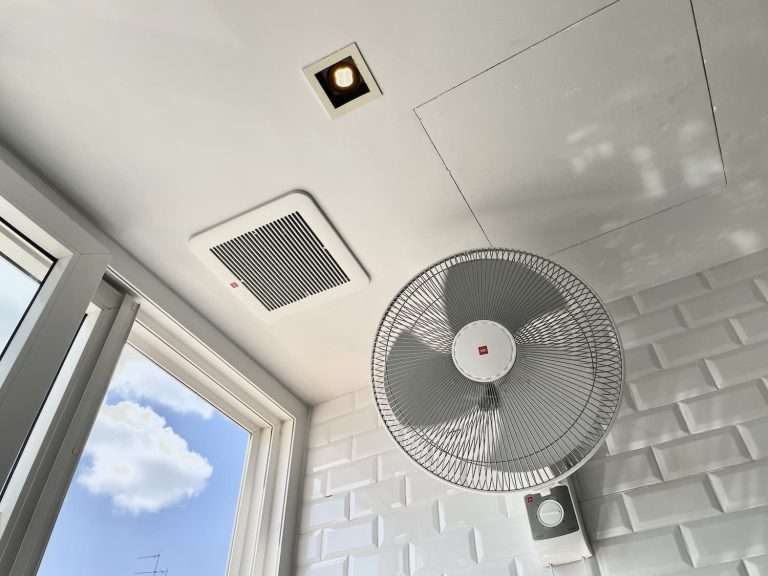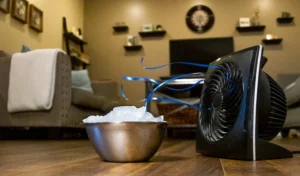Is your bathroom paint peeling?
Does the air feel heavy and damp long after a shower?
This common problem is caused by trapped moisture, which can lead to bigger issues.
A bathroom exhaust fan is essential for a healthy home.
Its main job is to pull damp air and smells out of the room.
This simple action helps stop mold growth and prevents damage to your walls, ceiling, and fixtures.
Without a fan, that moisture has nowhere to go.
It can seep into your walls and cause serious problems over time.
But understanding your fan is key.
Let’s look at why it’s so important and how to make sure it’s doing its job right.
Bathroom Exhaust Fan Vs Ventilation Fan
Are you confused about the different types of fans?
Choosing the wrong one means your moisture problems won’t get solved, and you’ll still face the risk of mold and peeling paint.
The main difference is simple.
A bathroom exhaust fan actively removes pollutants, odors, and moist air from inside your bathroom and pushes it outside.
A ventilation fan does the opposite; it is designed to bring fresh air from outside into a room.
Think of it this way: an exhaust fan takes the bad air out, while a ventilation fan brings the good air in.
They serve two very different purposes, and for a bathroom, the exhaust function is the most critical.
How They Work Differently
A bathroom exhaust fan is your first line of defense against the problems caused by excess humidity.
After a hot shower, the air in your bathroom is full of moisture.
This water vapor can cause a lot of issues if it isn’t removed quickly.
- Moisture Removal: The primary job of an exhaust fan is to pull this warm, humid air out of the room. A single five-minute shower can release about half a pint of water vapor into the air.
- Odor Control: Beyond moisture, exhaust fans are great at getting rid of unpleasant smells, keeping your bathroom fresh.
- Preventing Damage: By removing moisture, the fan helps prevent paint from peeling, fixtures from rusting, and wood from warping. Most importantly, it is a key tool in preventing the growth of mold and mildew, which thrive in damp environments.
A ventilation fan, sometimes just a simple ceiling fan, is different.
Its goal is to circulate air and introduce fresh air from another source, like the outdoors.
While this improves general air circulation, it does not solve the specific problem of high humidity in a bathroom.
A ceiling fan might just push the steamy air around the room instead of removing it, which doesn’t stop condensation on mirrors, walls, and ceilings.
For a bathroom, you need to get the moisture out of the house, not just move it around inside.
Why You Need an Exhaust Fan Specifically
In many homes, especially older ones, people might think that just opening a window is enough.
While a window helps, it’s not as effective or reliable as an exhaust fan, especially during cold or rainy weather when you are less likely to open it.
An exhaust fan provides controlled, consistent ventilation whenever you need it.
It creates negative pressure, actively pulling air out, which ensures the damp air is removed efficiently.
This is something a simple ventilation fan or an open window cannot guarantee.
A proper exhaust system is a crucial part of your home’s overall ventilation strategy, protecting its structure and ensuring better indoor air quality for your family.
Choosing The Right Exhaust Fan for Your Bathroom
Buying a fan might seem simple, but picking the wrong one is a waste of money.
A fan that’s too weak won’t clear the steam, and one that’s too loud will be so annoying you’ll never turn it on.
To choose the right fan, you need to match its power to your bathroom’s size.
This power is measured in CFM, or Cubic Feet per Minute.
For bathrooms under 100 square feet, the rule is simple: you need at least 1 CFM for every square foot of floor area.
Choosing the right fan involves more than just picking one off the shelf.
You need to consider its power, noise level, and even the size of your ductwork.
Getting this right ensures your fan will work effectively for years.
Understanding Fan Power (CFM)
CFM stands for Cubic Feet per Minute.
It tells you how much air a fan can move in one minute.
A higher CFM rating means a more powerful fan.
The key is to match the CFM to your bathroom’s size so it can clear the air efficiently.
- Small Bathrooms (Under 50 sq. ft.): For a small powder room or half-bath, a fan with a rating under 79 CFM is usually enough.
- Medium-Sized Bathrooms (50-100 sq. ft.): If your bathroom is in this range, look for a fan with 80 to 99 CFM. For example, an 8-foot by 10-foot bathroom is 80 square feet, so it needs a fan with at least 80 CFM.
- Large Bathrooms (Over 100 sq. ft.): For larger spaces, you need more power. A fan over 100 CFM is recommended.
Calculations for Extra-Large or Complex Bathrooms
Once your bathroom is over 100 square feet, the calculation changes.
Instead of square footage, you calculate CFM based on the fixtures in the room.
This ensures you have enough power to handle the moisture produced by each source.
- Add 50 CFM for each toilet, standard bathtub, or shower.
- Add 100 CFM for a jetted tub or whirlpool.
For example, a large bathroom with a shower, a toilet, and a jetted tub would need a fan with at least 200 CFM (50 + 50 + 100).
Don’t Forget About Noise and Duct Size
No one wants a fan that sounds like a jet engine.
Fan noise is measured in sones.
- A lower sone rating means a quieter fan.
- Look for a fan with a rating of 1.5 sones or less for quiet operation.
- Some people find ultra-quiet fans (less than 0.5 sones) so silent they forget they are on.
Also, check your duct size.
Most newer homes have 4-inch ducts, while older homes may have 3-inch ducts.
Fans designed for 4-inch ducts generally have better airflow.
You can buy a fan to fit your existing ductwork, but remember that a smaller duct can limit the effectiveness of a powerful fan.
Bathroom Exhaust Fan Best Practices & Maintenance
You bought a powerful, quiet fan.
But if it’s not installed correctly or you never clean it, you’ll still see moisture stains on the ceiling and wonder why it’s not working.
For your fan to work its best, it must be vented directly to the outside of your home, not into the attic.
Use an insulated duct for the vent line.
This prevents condensation from forming inside the duct and dripping back down, which causes water stains and mold.
Proper installation and regular maintenance are just as important as choosing the right fan.
A few simple steps can keep your fan running efficiently, protect your home from damage, and extend the life of the motor.
Best Practices for Installation
The goal of installation is to create a clear, efficient path for moist air to exit your home.
- Vent to the Outside: This is the most important rule. Venting into an attic, crawlspace, or wall cavity simply moves the moisture problem to a hidden area, where it can cause mold, rot, and serious structural damage. The vent should lead through the roof or a side wall to the exterior.
- Use Insulated Ducts: An insulated sleeve or duct is highly recommended. As warm, moist air from your bathroom travels through a cold attic, the moisture can condense into water inside the duct. Insulation keeps the duct temperature stable, preventing condensation and ensuring air flows out efficiently.
- Ensure Proper Air Makeup: A fan can only remove as much air as can be replaced. Usually, the gap under the bathroom door provides enough “makeup air” for the fan to work well. If your bathroom is tightly sealed, the fan may struggle to pull air out.
Regular Maintenance and Cleaning
A dirty fan can’t do its job.
Dust, lint, and hair clog the blades and motor, reducing its power and creating a potential fire hazard.
You should clean your fan at least every six months.
Simple Maintenance Checklist:
- Turn Off the Power: For safety, always turn off the power to the fan at the circuit breaker before cleaning.
- Clean the Cover: Gently pull the cover down. Most can be washed with warm, soapy water. If your cover has a light or speaker, do not submerge it; wipe it with a damp cloth instead.
- Vacuum the Inside: Use a vacuum with a brush attachment to clean the fan blades and the housing around the motor. Be gentle with the blades.
- Check the Exterior Vent: Go outside and make sure the vent flap is not blocked by debris, leaves, or animal nests. A blockage can stress the motor and reduce airflow.
The Toilet Paper Test
Not sure if your fan is actually working?
Don’t just listen for noise.
A fan can make noise even if the motor is failing and not moving any air.
Try this simple test:
- Turn the fan on.
- Hold a couple of squares of toilet paper up to the fan’s cover.
- If the fan is working properly, the suction will hold the paper against the cover.
- If the paper falls, your fan is not moving air and needs to be cleaned or replaced.
Conclusion
A bathroom exhaust fan is not just a nice feature; it’s a vital part of your home.
It protects your bathroom from moisture damage, stops mold, and keeps the air fresh and healthy.
Frequently Asked Questions
1. Is it OK to not have an exhaust fan in a bathroom?
It is not recommended, as it can lead to mold, mildew, and structural damage from trapped moisture.
Building codes in many areas now require them.
2. What happens if you don’t use a bathroom fan?
Without a fan, moisture from showers builds up.
This can cause paint to peel, fixtures to rust, and mold to grow on walls and ceilings.
3. How long should you run a bathroom fan after a shower?
It is recommended to run the fan for about 20 minutes after you shower.
This ensures all the excess humidity is removed from the room.
4. Should a bathroom fan be on the same switch as the light?
It is better to have the fan on a separate switch or a timer.
This allows you to run the fan for the recommended 20 minutes after you leave the room and turn off the light.
5. Can a bathroom exhaust fan cause a fire?
It’s rare, but possible.
A blocked vent or a motor clogged with dust and lint can overheat, creating a fire hazard.
Regular cleaning prevents this.
6. Do you need a fan in a bathroom with a window?
Yes.
A window doesn’t provide reliable ventilation, especially in bad weather.
A fan provides consistent moisture removal whenever you need it.
7. Why is my bathroom fan so noisy?
Loud noises can mean the fan is old, clogged with debris, or the motor is failing.
Cleaning it may help, but a very loud fan may need to be replaced with a quieter model.







